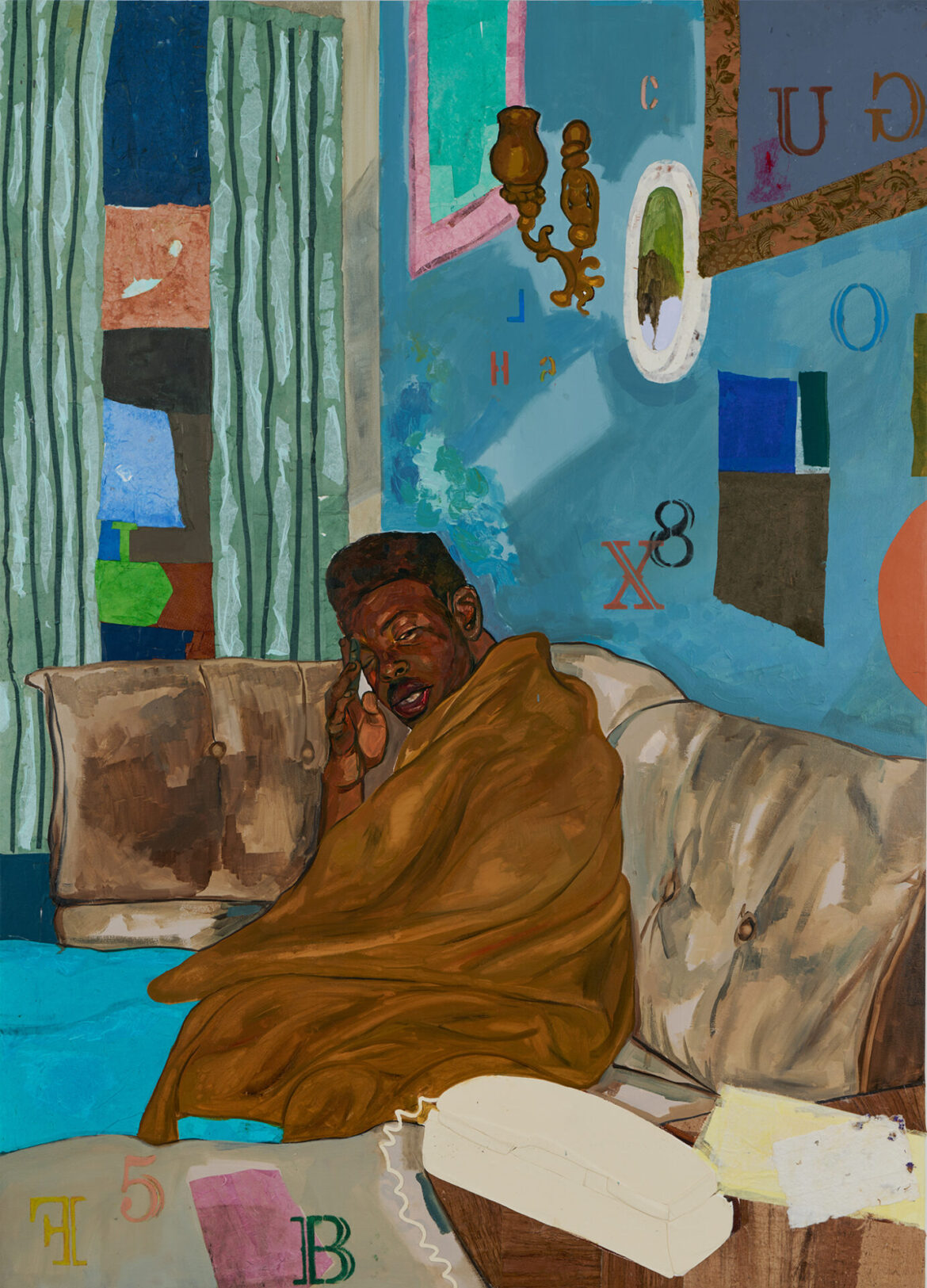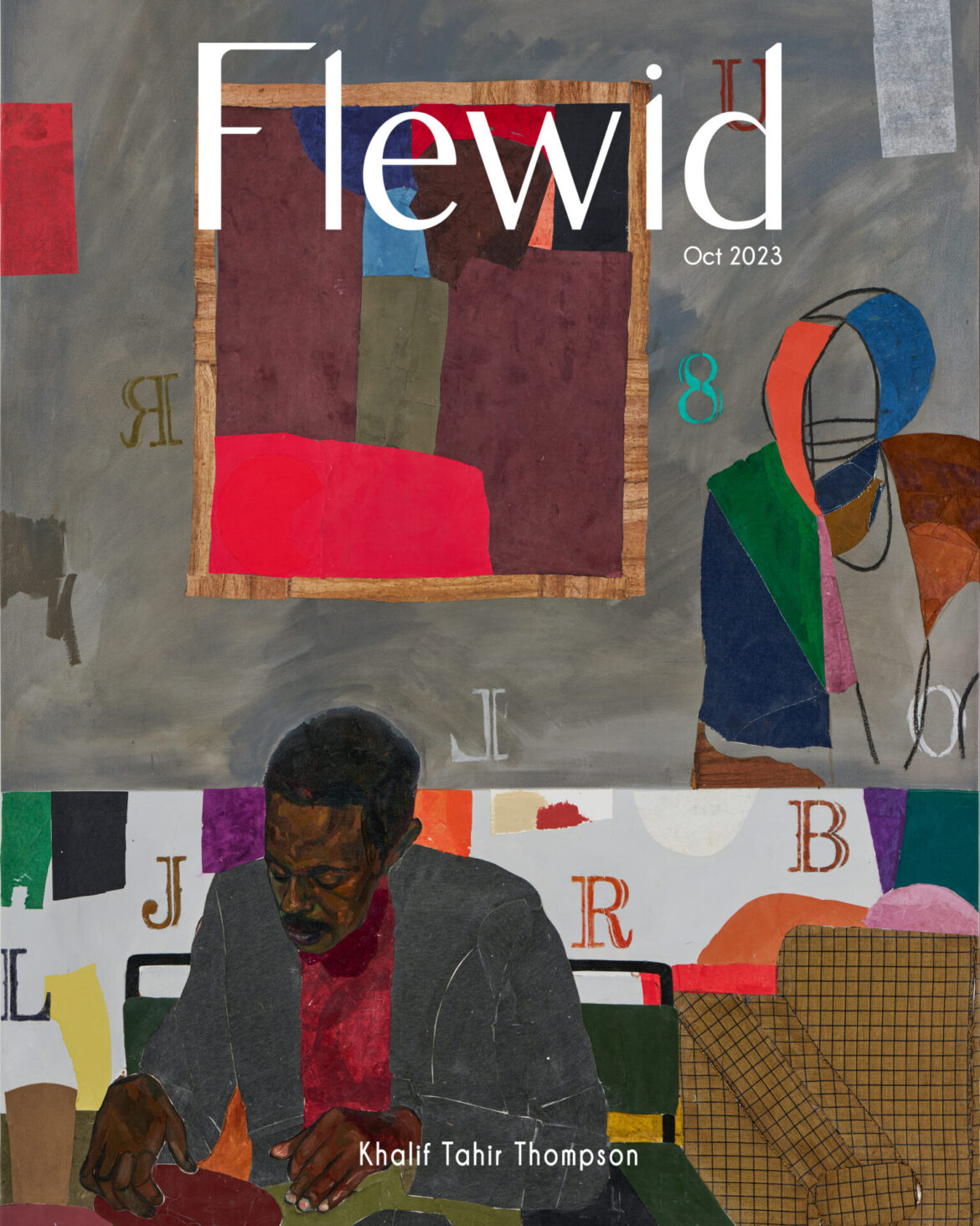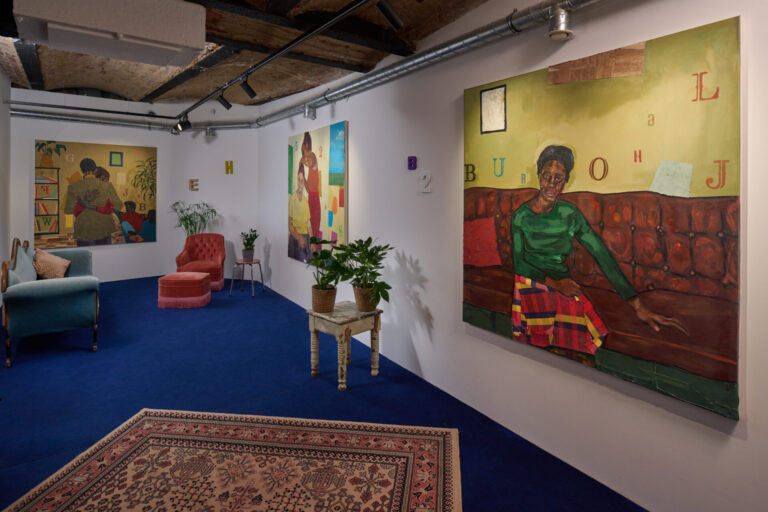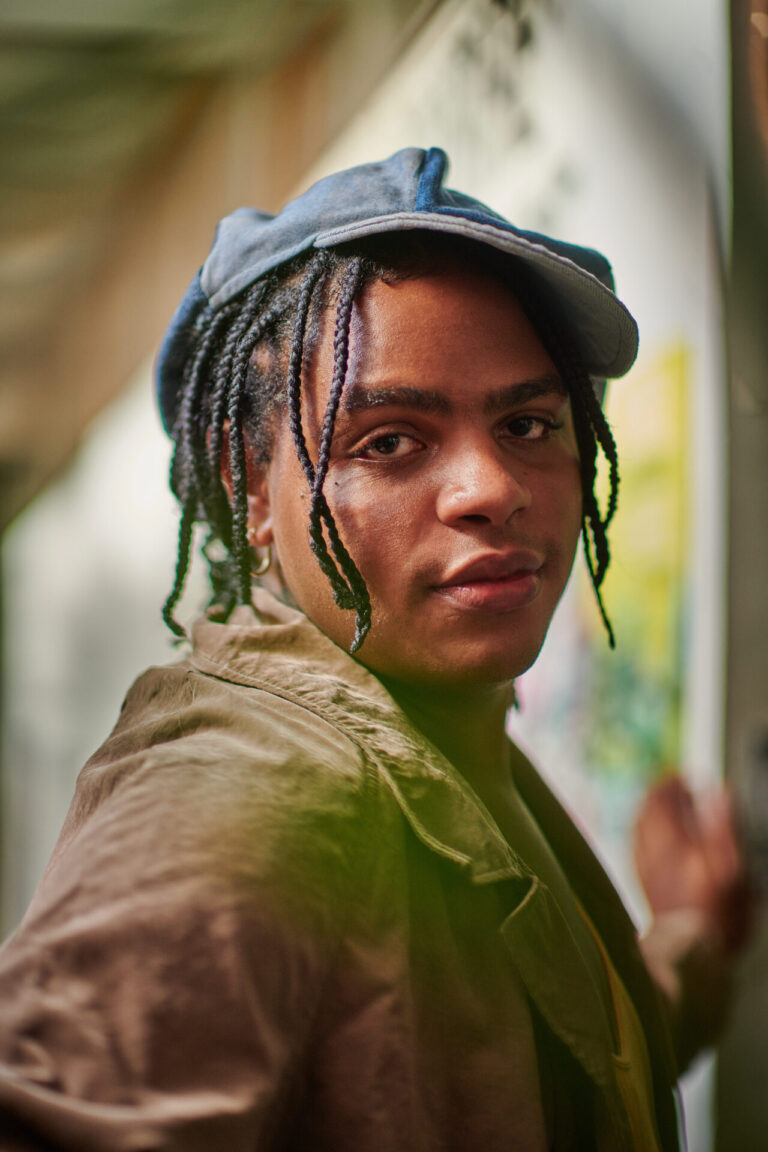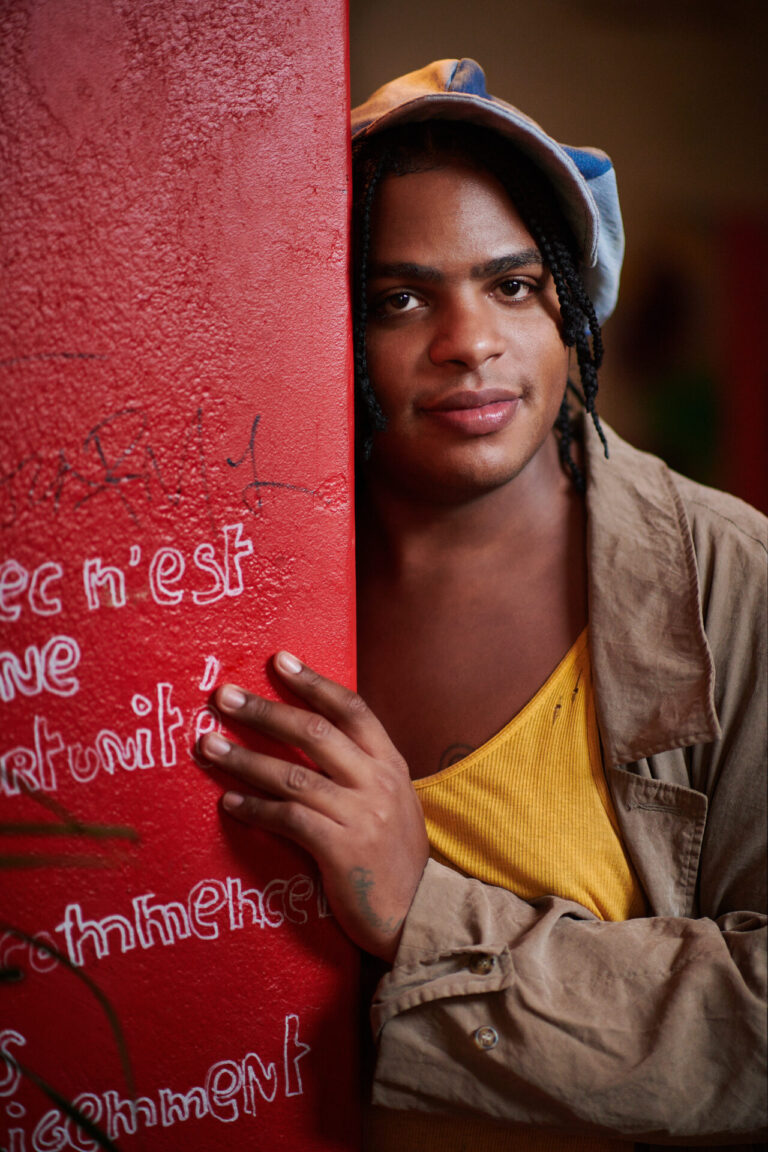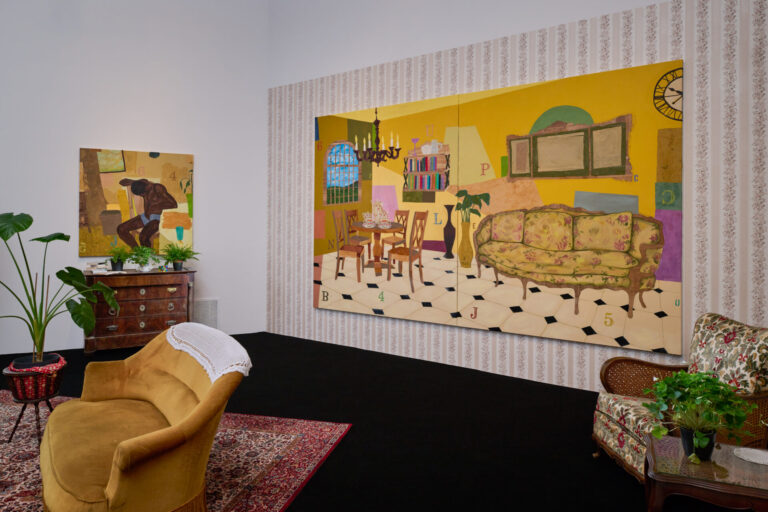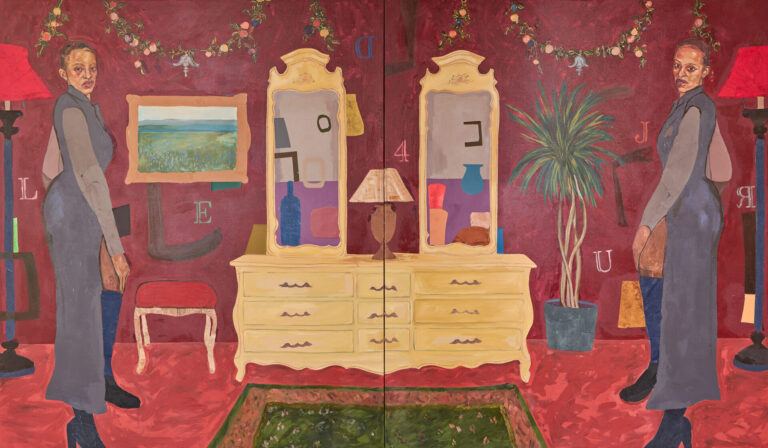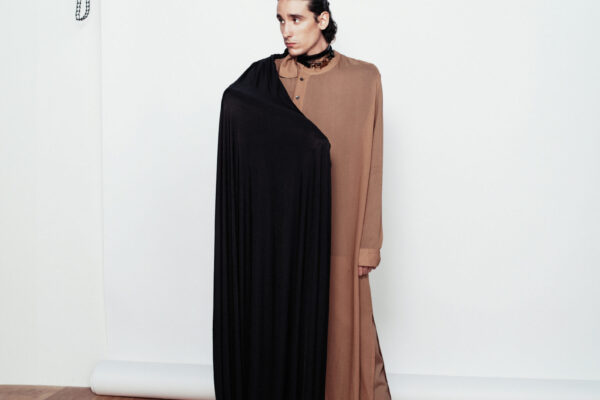Photography Mattia Baldi
Exhibit Photography courtesy of Gallery Zidoun-Bossuyt
DIGITAL COVER STORY
(cropped for the layout)
Interview Veronica Costanza Ward
Khalif natural talent for identity representation
Khalif Tahir Thompson, the young prodigious artist, between painting, collage, identity and community environment.
Khalif talks to me in the phone from Luxemburg, where his first European show is a success. 17 pieces are exposed in big formats and he’s still excited by the of the exhibition open until November the 11th.
He sounds like a conscious young person, focused and definitely connected to his familiar dimension, to his roots and memories which bring him back to his grandmother living room where his paintings took shape in his mind while he was studying subjects living and moving within space and time.
Collage is the world that can represent Thomson’s art in terms of technique, style, references (and look!).
Next stop: Paris.
“Khalif Tahir Thompson mixes painting, drawing, collage, printmaking, and paper-making into his practice, while exploring notions of self through the scopes of race, sexuality, and spirituality.” Khalif, do you see yourself in this description?
Yes I do, a lot of my work has to deal with family relationships intimacy and ideas concerning the human condition and so a lot of the times my images depict these things through the tactile nature of the medium as well as the painterly aspect. Historical art and the psychological dimension come together and they represent a lot of my motivations as an artist.
So young, already present in important galleries through US, a bachelor in Purchase College, a fellowship at the EFA Robert Blackburn, Printmaking Workshop in NYC, the Vermont Studio Center, and the Jerome Emerging Artist residency at The Anderson Center. You were selected as a member of Kehinde Wiley Black Rock Senegal residency in 2022. Now in Europe for a solo exhibition at Zidoun-Bossuyt Gallery in Luxembourg ? Wow, how do you feel about all this?
I’m completely exalted, excited and overwhelmed and I couldn’t have imagined, once I graduated with my bachelor’s degree that my career would take such great steps forward in the years following. I believe it’s all about concentrating and remaining focused and continuing that growth.
When have you understood you were becoming an artist? Was the need to express yourself and to intimately describe the world around you the push to start for your art?
I probably understood I was an artist from a very young age I always was very interested in art my brothers and my whole family, they were very creative and artistic and my mom always supported and pushed creative fields like singing and art and writing and play drama. I was always very interested in recording time, documenting life, creating honorifics memorabilia reflecting spaces of thought and memory that were always very important to me.
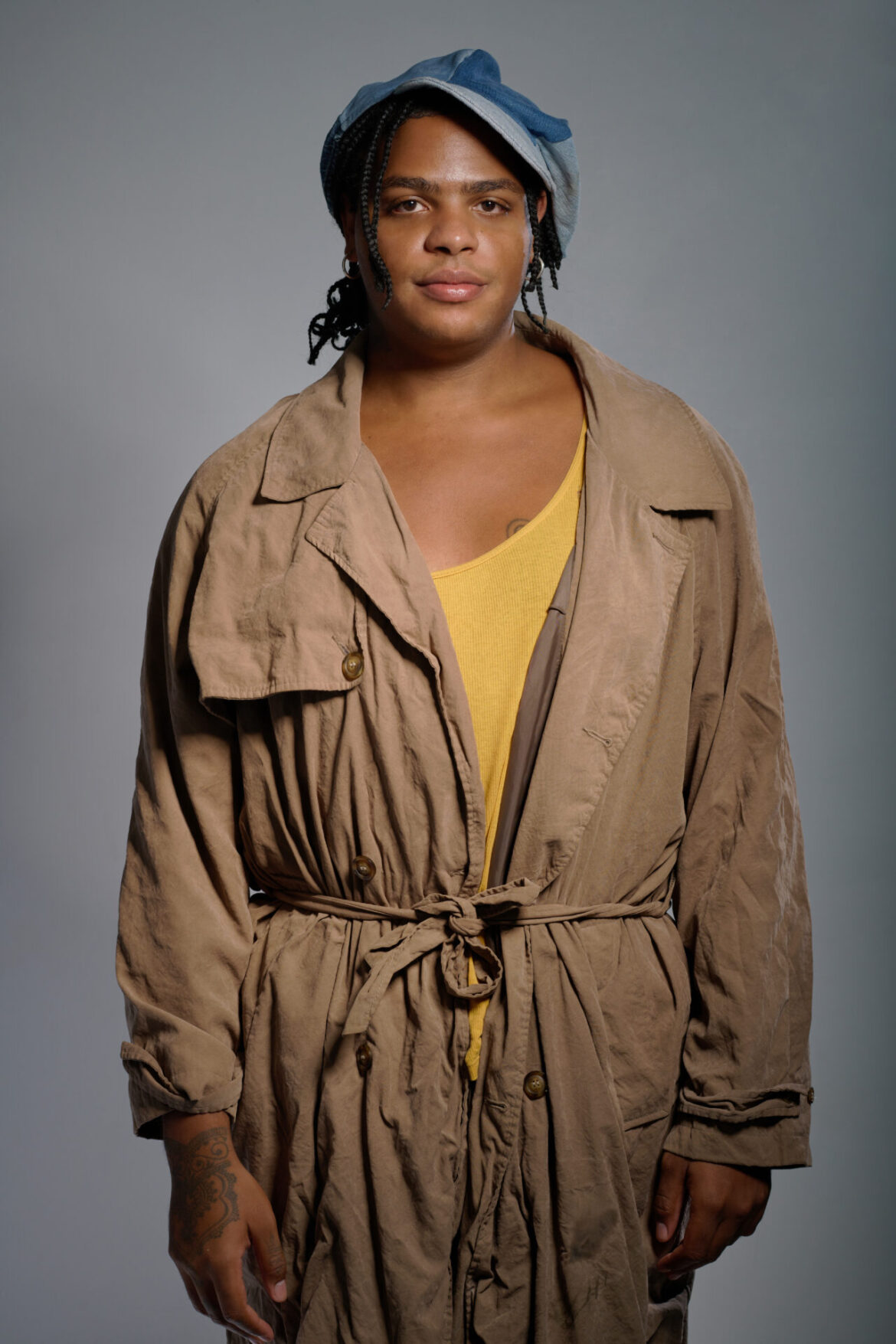
In terms of identity research, how was your art influenced?
I did a lot of searching for my identity as an artist within the contemporary art landscape and much of my identity came from just art heroes and different artists that I looked up to and aspire to be like and to being conversation with as well as my own personal motivations and my own personal story that I brought within this framework painting and art. It’s kind of a mix of myriad of influences that created my artistic identity that is reflected from my personal life and my personal identity.
You focus on portraiture configuration subjects include family friends and cultural figured places with construction settings.
I went to high school for art and I studied fine art from the age of 13 and before that it was always an art programming and things such as that I have always been interested in portraiture figuration visiting different important museums that hosted a lot of portraiture life Brooklyn Museum and studying a lot of the important influential artists that I always was taken with were artists that were making portraits and figures and painting. I found myself to have an affinity towards painting certain subjectivity, I mean, this kind of subjectivity having to do with people and personages. I began painting when I was around 16 and so somehow it just developed further and further into collage and paper making. The different formats I learned while I was an undergraduate all became involved in the overall practice.
Who in history or contemporary is the artist you feel close to that moves you and inspires you?
Incorporating makes me feel collage and to build that tragic environments exist so when history or contemporary is the artist that you love the most that moves you inspires you know yeah that’s a myriad of artists you know I’d like to think that I got really interested in start contemporary black artist and figuration portraiture just in the last 10 or so years. People like Jennifer Packer Mickalene, Thomas Kerry, James Marshall or Derek Adams, a lot of the artists that really have become quite successful and ventured in art history. They were able to build their own kind of language and world from their practice that really expands and expands every day and so that was super inspiring as far as contemporary artists that are living today.
You can actually make papyrus. How did you learn and why did you choose this handcraft?
I studied handmade paper it’s an undergraduate and once I learned about the medium and its history and the history of paper making and how far back it goes I really wanted to include that kind of tactile handmade paper that had almost a visceral effect once looking at it within a painting, it was a great tool for me to explore texture and surface with the paintings in tandem with the oil paint and the more collage elements make profiles. I learned how to make a fiber that’s called Tifa in Senegal in a small village where they actually makes their own paper using strips of it after soaking fibers for a whole day and in a lattice formation create paper and pressing it but there’s many different fibers that learn to work with, papyrus is just one that I gravitated towards, just as a common paper but a very well textured beautifully toned natural kind of grain wood kind of paper that I like.
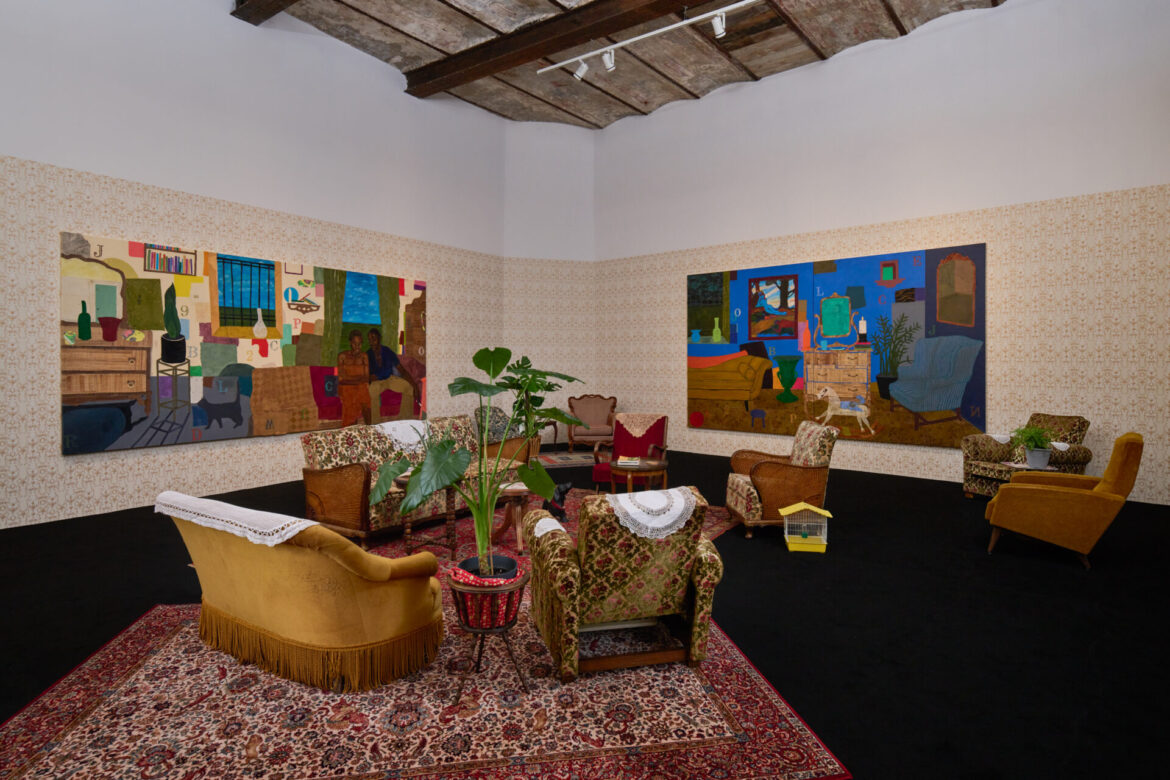
I can ‘see’ my American family in your works, I can see subjects ‘of my memory’ and Afro-American family history. I can see the handcraft books that my grandmother use to send me back here in Itay. Is the link to your roots, your community a starting point for your work?
In the in the last couple of few years and in this current body work they’re directly sourced from my grandmother’s photo albums and my family albums recommending you know pretty much African American experience in life over the last you know 21st century and so a lot of those images and photographs that I came upon after a while served to be directly inspirational for a lot of the images that are included in the work of my last show and the work I’m continuing to make and venturing out into other subjectivity but the initial kind of familiar image was directly inspired by my grandmothers, my maternal grandmothers photo albums.
Where did you ‘learn’ your technique, how much of traditional Afro-American community handcraft influenced your work?
As far as the oil painting and painting concerned I was in a class in high school where I was able to paint and I kind of took the opportunity to pretty much self-guided kind of practicing of the meeting took place, I had a small affinity for oil paint and I kind of really enjoyed that medium and from there I ventured out and studied more mediums concerning print making and the handmade paper and all of that was done mostly during my undergraduate studies. Certain artists and formats taught me, just through observational learning, just in terms of technique and form and color, how to use shapes and how cut out certain things and place them on paintings so it’s kind of been more of an organic approach towards learning and creating this kind of images.
I think that the black or historical influence on my work was obviously through my influences within black artist and artists like Jacob Lawrence and Charles White but I just growing up in Brooklyn and being from New York, being constantly surrounded by art and artist and kind of these different art movements probably have influenced my technique and how I work in a natural and spontaneous way. I don’t have a finite technique but definitely a collage of different techniques kittens fluctuating from.
Your paintings fluctuate from tangible to ethereal, framing the viewer perception towards their pain, joy, questioning, resolving. What are the subject telling us?
The subjects are introduced to viewers as a way of reflecting on themselves thinking about their own experiences, on life in general, helping them invoking a certain sympathy towards the subject.
Can you tell us a little bit more on the frame, the environment you subject are in? They mostly seem in home or comfort situation. Do you start from the pictures, the mood, the moment or do you just take the subject and create a new environment for them?
A lot of the settings were different interiors and different domestic spaces like the family home, my grandmother’s home and or comfortable situations. Again it’s a mixture of both, usually when I’m looking at an image, especially a photograph or something like that I do like to honor the photographs composition and kind of the storytelling that I get from the photographs but then as I’m working and I’m building the environments and the settings, I open them up and create new worlds, a new world building where the collage the paper the landscapes the different paintings hidden paintings become portals into other realms or universes, abstract the domestic into something that’s more ethereal and transient . It’s about perceiving, creating sometimes it’s the light or the shapes or the textures or maybe even the subject themselves and inspire different things Within the actual paintings so they kind of build themselves in a again a very intuitive way that kind of seeks to have different conversations and never merely be one thing or one clear image. I one clear motivation for the work.
Your personal look is definitely oroginal and we love it, how do you define yourself if you do and how do you choose your outfits and looks? Who influenced your choices regarding fashion, style, beauty?
Thank you! I just like to dress comfortably, I do like a certain time nice embellishments, I love big coats and more baggy clothing but really just anything that’s well made, I like to rewear things a lot and I think fashion is another thing that I’m quite in style is something that I think is related to a lot of artists, how they choose to dress how they choose to carry themselves in their home and represent. My look is very connected to my interests in color and so I like lots of warm tones and lots of great textures, lots of bold accessories and I like my hair certain way and all that and it’s kind of again more about just being comfortable. The more I understand art and artwork the more I understand what I like to wear and how I represent myself because, it kind of goes down to what I’m attracted to in terms of form and color and texture and you know it’s kind of I think all related but it’s not I’m specifically too concerned about. Look and art kind of overlap. A lot of the time I’ll dress for work and just naturally for an opening or something and it’s not my intention but I think it’s just my style and intuition is very, hoe an I say, specific!
